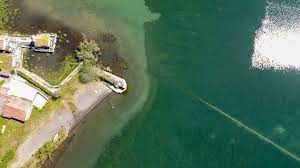Italy: Utility in hot water for draining a picturesque lake to send water to Rome

Rome: Francesco Falconi stood at the edge of Lake Bracciano, a volcanic depression filled with crystalline water and surrounded by bucolic wooded hills and ancient Italian villages.
“This is where I used to dive into the lake,” Falconi, a lawyer who grew up in one of those villages, says, pointing to a rock on the lake’s periphery. Jump from there today, and you would probably wake up in the nearest emergency room.
In 2017, Lake Bracciano, a basin of around 22 square miles, faced an existential crisis. It started to dry up as a local utility, the Acea Group, diverted its waters to quench the thirst of the Italian capital during a severe drought. Residents of the surrounding villages were able to stop the water company from draining the lake, but the damage was done. Habitat and ecosystems were lost, and the lake has never fully recovered. Now, they are bringing the company to court for environmental crimes.
The trial could set a precedent throughout Europe, by creating more public awareness about environmental crimes that involve water use and drainage, a long-overlooked issue, in addition to water pollution. It could inspire other small communities to fight to safeguard their natural havens and force big cities to find new solutions to deal with their water needs.
The Lazio region, where Rome and Lake Bracciano are located, is rich in lakes, rivers, and pristine springs, but frequent droughts, climate change, and terrible water management are creating a recurring state of crisis.
Lake Bracciano serves as an emergency water reservoir for Rome. The city meets two-thirds of all its water needs by tapping into the Peschiera springs at the base of Mount Nuria. These founts are very resilient to occasional droughts. Other sources are smaller and dry up faster, though in general, all the regional water sources, including Lake Bracciano, are steadily declining due to climate change.
In the first six months of 2017, a very dry year, the elevation of the water surface of Lake Bracciano fell by five feet as Acea kept tapping into the basin. It is normal for the surface of the lake to fluctuate between a height of 535 and 538 feet above sea level, but that summer it plummeted to 530 feet. It might seem a small change on paper, but five feet over 22 square miles adds up to a lot of water; the loss was enough to disrupt nearly everything around the lake. Ferries could no longer dock at piers. Stairs had to be built for people to disembark because of the shallow waters. And even after Acea stopped collecting water, Lake Bracciano kept shrinking. It had lost its normal equilibrium.
In 2018, the lake reached its nadir. The water surface fell by six-and-a-half feet in total. The shoreline retreated by a mile. The sight of the shoal between the lake’s normal shore and its new, shrunken state was ominously reminiscent of the Aral Sea, the enormous lake lying between Kazakhstan and Uzbekistan, which almost disappeared due to the deadly combination of increased human thirst and climate change.
“The lake never goes down [below] a certain threshold,” Graziarosa Villani says. Villani is the president of the committee of local citizens that managed to save Lake Bracciano, thanks to the quick mobilization of scientists and lawyers. The group pressured the regional government, which stopped the draining. Acea appealed, but the “Cassazione,” the highest Italian court, upheld the decision.
During the trial, the people of Lake Bracciano were up against two giants: Acea, the local private company providing water to the region in a de-facto monopoly situation, and the city of Rome. But the law worked in their favor. According to its permits, Acea could draw from Lake Bracciano as long as the water surface did not drop under a certain level, to ensure that the basin did not enter a dangerous downward spiral. “But Acea did not stop there and went even further,” Villani says. “Who knows what would have happened without our intervention?”





